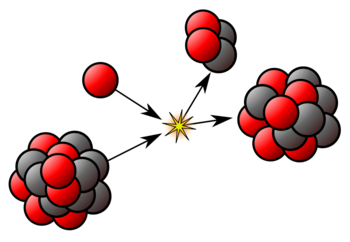Nuclear binding energy is the
minimum energy that would be required to disassemble the
nucleus of an
atom into its component parts. These component parts are
neutrons and
protons, which are collectively called
nucleons. The binding energy is always a positive number, as we need to spend energy in moving these nucleons, attracted to each other by the
strong nuclear force, away from each other. The
mass of an atomic nucleus is less than the sum of the individual masses of the free
constituent protons and neutrons, according to Einstein's equation E=mc2. This 'missing mass' is known as the
mass defect, and represents the energy that was released when the nucleus was formed.
The term "nuclear binding energy" may also refer to the energy balance in processes in which the nucleus splits into fragments composed of more than one nucleon. If new
binding energy is available when light nuclei fuse (
nuclear fusion), or when heavy nuclei split (
nuclear fission), either process can result in release of this binding energy. This energy may be made available as
nuclear energy and can be used to produce electricity, as in
nuclear power, or in a
nuclear weapon. When a large nucleus
splits into pieces, excess energy is emitted as photon (gamma rays) and as the kinetic energy of a number of different ejected particles (
nuclear fission products).
These nuclear binding energies and forces are on the order of a million times greater than the
electron binding energies of light atoms like hydrogen.
[1]
The mass defect of a nucleus represents the amount of mass equivalent to the binding energy of the nucleus (E=mc2), which is the difference between the
mass of a nucleus and the
sum of the individual masses of the nucleons of which it is composed.

